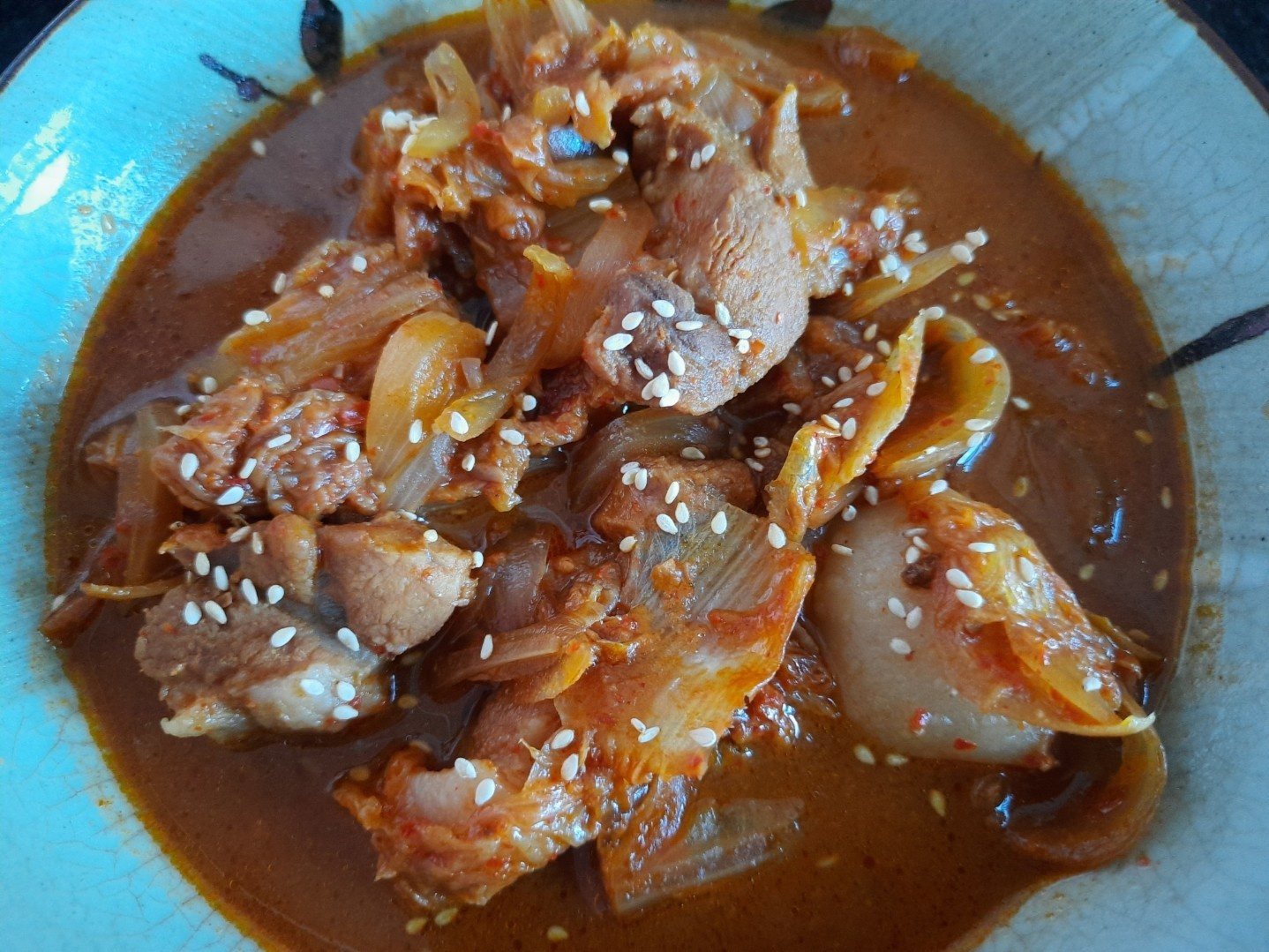Easy Rice Cooker Pork Kimchi Stew
How to Make Delicious Pork Kimchi Stew Using a Rice Cooker

Make a rich and savory pork kimchi stew effortlessly with your rice cooker. No more worrying about burning! It’s a perfect, warming dish for a chilly day, best enjoyed with a bowl of hot rice.
Main Ingredients- Pork (recommend cuts with some fat) 250g
- Well-fermented Kimchi 200g
- Onion (medium size) 1/4 piece (approx. 50g)
- Kimchi brine 50g (approx. 1/4 cup)
- Water 180ml (approx. 3/4 cup)
- Sesame seeds, a pinch
Seasoning Ingredients- Sugar 1 Tbsp
- Doenjang (Soybean Paste) 0.5 Tbsp
- Garlic Powder (or minced garlic) 1 tsp
- Guk-ganjang (Soup Soy Sauce) 1 Tbsp
- Gochugaru (Korean Chili Flakes) 1 tsp
- Sugar 1 Tbsp
- Doenjang (Soybean Paste) 0.5 Tbsp
- Garlic Powder (or minced garlic) 1 tsp
- Guk-ganjang (Soup Soy Sauce) 1 Tbsp
- Gochugaru (Korean Chili Flakes) 1 tsp
Cooking Instructions
Step 1
First, cut the pork into large, bite-sized pieces, about 2-3cm. Pork belly, neck, or shoulder cuts with a good amount of fat work best for a tender and flavorful stew. Chop the well-fermented kimchi into similarly sized pieces. Place the chopped kimchi at the very bottom of your rice cooker pot. This layer prevents the kimchi from sticking to the bottom and allows its flavor to deeply infuse into the pork as it cooks.

Step 2
Next, arrange the 250g of pork pieces evenly over the kimchi layer. While any cut of pork will work, choosing one with a good balance of meat and fat will result in a much more moist and delicious kimchi stew. For this recipe, pork shoulder was used.

Step 3
Pour about 50g (approximately 1/4 cup) of kimchi brine over the pork. This brine adds a wonderful umami depth and also provides essential moisture to keep the stew from drying out.

Step 4
Now it’s time to add the seasonings. Sprinkle 1 tsp of garlic powder (or minced garlic), 1 tsp of gochugaru (Korean chili flakes), 1 Tbsp of sugar, 0.5 Tbsp of doenjang (soybean paste), and 1 Tbsp of guk-ganjang (soup soy sauce) evenly over the ingredients. (Tip: If you enjoy a spicier kick, finely chop half a Cheongyang pepper and add it in for extra heat.)

Step 5
Add the sliced onion (about 50g, which is 1/4 of a medium onion) on top of the pork and seasonings. The onion will soften and sweeten as it cooks, enhancing the overall flavor of the stew.

Step 6
Finally, pour 180ml (approximately 3/4 cup) of freshly boiled hot water into the rice cooker, just enough to partially cover the ingredients. Be careful not to overfill. Using hot water helps the ingredients cook more efficiently and preserves their natural flavors.

Step 7
Close the lid of the rice cooker and select the ‘Reheat’ or ‘Steam’ function, cooking for 9 minutes. Depending on your rice cooker model, the menu names might vary, so choose the setting that cooks at the highest temperature for a short duration.

Step 8
After the initial 9-minute cooking cycle, carefully open the lid and stir everything with a spatula, ensuring the doenjang dissolves well. Once everything is mixed, close the lid again and use the ‘Reheat’ or ‘Steam’ function to cook for another 9 minutes, repeating this process twice for a total of 18 minutes of additional cooking. This double cooking ensures the ingredients become tender and the flavors meld beautifully.

Step 9
Once the second reheat cycle is complete, keep the lid closed and set the rice cooker to ‘Keep Warm’ for 20 minutes. This resting period allows the flavors to deepen further, ensuring the kimchi stew is rich and perfectly seasoned.

Step 10
After 20 minutes on ‘Keep Warm’, open the lid. Serve the delicious pork kimchi stew in a bowl. Garnish with a pinch of sesame seeds for an added nutty aroma. Enjoy it spooned over hot rice or as a flavorful side dish!



